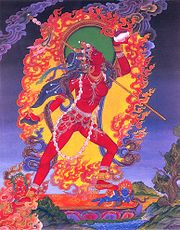- Narodakini
-
 Nãrodãkinĩ (Patan, Nepal[1]), last decade of 20th century, Paubhã, detail. Pigment and gold on cloth. 16.4x13.25in.(19.4x33.65cm). Miranda Shaw private collection. Nãrodãkinĩ's red body and rippling hair are illumined by her aureole of yogic fire and adorned with gleaming bone ornaments. Nãrodãkinĩ' raises her brimming skull bowl, ever imbibing the promordial bliss that pulses at the heart of reality[2].
Nãrodãkinĩ (Patan, Nepal[1]), last decade of 20th century, Paubhã, detail. Pigment and gold on cloth. 16.4x13.25in.(19.4x33.65cm). Miranda Shaw private collection. Nãrodãkinĩ's red body and rippling hair are illumined by her aureole of yogic fire and adorned with gleaming bone ornaments. Nãrodãkinĩ' raises her brimming skull bowl, ever imbibing the promordial bliss that pulses at the heart of reality[2].
Nãrodãkinĩ is a Tibetan deity[3] similar to Vajrayogini[4][5] (red, striding, bearing a vajra), which no longer appears in the active Tantric pantheon, despite its importance in late Indian Buddhism. In the Sadhanamala, a sacred text, she is said to be a transformation/emanation of Vajrayogini[6]. Nãrodãkinĩ, or Naro Khachöma[7], is readily recognizable by her lunging posture and raised skull bowl (kapala). Her head is uptilted, poised to imbibe the blood that overflows her skull bowl, and her right hand brandishes a curved knife (kartika). Nãrodãkinĩ's physical attributes are interpreted with reference to long-standing Buddhist principles as well as distinctively Tantric concepts. For example, her freely flowing hair is, in the Indic setting, a mark of a yogic practitioner, especially one who cultivates psychic heat[8], whereas Buddhist exegetes interpret the unbound tresses as a sign that her mind, free from grasping, is a flowing stream of nonconceptuality[9][10][11][12]. Her crown of five skulls represents her transformation of the five aspects of selfhood into the five transcendental insights of a Buddha. Her garland of fifty severed heads symbolizes her purification of the fifty primary units of language and thought. Her bone ornaments represent five of the six perfections of a bodhisattva. Her body itself represents the sixth perfection, transcendent wisdom (prajna), which all female deities implicitly personify. Nãrodãkinĩ carries a mystical Staff (khatvãnga[13][14]), supported by her left arm or balanced across her left shoulder. The staff indicates that she is not celibate and has integrated[15] eroticism into her spiritual path, mastering the art of transmuting pleasure into transcendent bliss[16].
She manifested herself in an initiatory vision to the great Indian Teacher and Mahasiddha Naropa, (A.D. 956-1040) who received teachings from her, and his disciples began calling her Naro Dakini or Vajrayogini Naro Kha Chod or Naro Sky Goer. Moreover she is patroness of Sakya sect and an acolyte of the Dakini Vajravarahi. She is a Sarvabuddhadakini having access to all the Buddhas and thus is more powerful. This form of Vajrayogini or Dakini is the preeminent form of Yogini in the Chakrasamvara and Vajravarahi Tantras. [17].
See also
- Sitatapatra
- Nairatmya
- Saraswati
- Queen Maya
- Hariti
- Yakshini
- Prithvi
- Simhamukha
- Vajrayogini
- Tara (Buddhism)
References
- ^ Vajrayogini Temple, Lonely Planet Nepal by Bradley Mayhew, Joe Bindloss, and Stan Armington (2006) p.214
- ^ Buddhist Goddesses of India by Miranda Shaw (2006)
- ^ The World of Tibetan Buddhism: An Overview of Its Philosophy and Practice by Dalai Lama (1995) p.113
- ^ Vajrayogini: Her Visualizations, Rituals, and Forms (Studies in Indian and Tibetan Buddhism) by Elizabeth English (2002)
- ^ Guide to Dakini Land: The Highest Yoga Tantra Practice of Buddha Vajrayogini by Kelsang Gyatso (1996)
- ^ [1]
- ^ A Saint in Seattle: The Life of the Tibetan Mystic Dezhung Rinpoche by David P. Jackson (2004)
- ^ The Encyclopedia of Tibetan Symbols and Motifs by Robert Beer (1999) p.23
- ^ Buddhist Wisdom: The Diamond Sutra and The Heart Sutra by Edward Conze, John F. Thornton, Susan Varenne, and Judith Simmer-Brown (2001)
- ^ Mahamudra: The Moonlight -- Quintessence of Mind and Meditation by Dakpo Tashi Namgyal, The Dalai Lama, and Lobsang P. Lhalungpa (2006) p.88
- ^ Mind at Ease: Self-Liberation through Mahamudra Meditation by Traleg Kyabgon (2004) p.18
- ^ Essence of Buddhism (Shambhala Dragon Editions) by Traleg Kyabgon (2001) p.146
- ^ The Encyclopedia of Tibetan Symbols and Motifs by Robert Beer (1999) p.110
- ^ The Tibetan Book of the Dead (Mystical Classics of the World) by Robert Thurman and Huston Smith (1993) p.163
- ^ Dancing in the Flames by Marion Woodman (1997) p.43
- ^ Introduction to Tantra : The Transformation of Desire by Lama Yeshe, Jonathan Landaw, and Philip Glass (2001)
- ^ Sarvabuddhadakini (Naro Dakini): The First Feminist
Link
- Sarvabuddhadakini (Naro Dakini): The First Feminist taken from Exotic India
Buddhism Buddhism portal Categories:- Dakinis
- Yidams
- Female buddhas and supernatural beings
Wikimedia Foundation. 2010.
